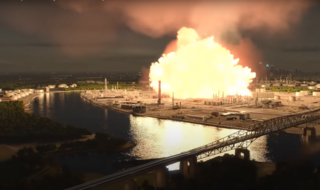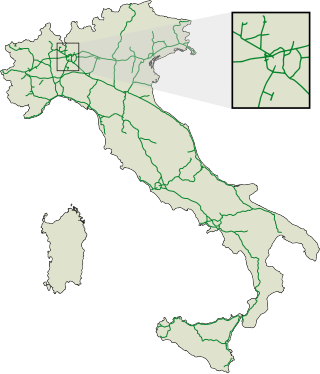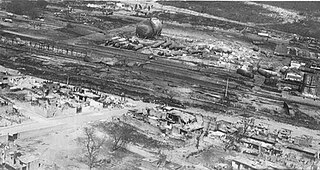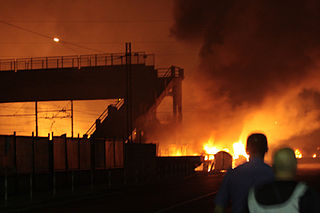
Liquefied petroleum gas, also referred to as liquid petroleum gas, is a fuel gas which contains a flammable mixture of hydrocarbon gases, specifically propane, n-butane and isobutane. It can sometimes contain some propylene, butylene, and isobutene.

A boiling liquid expanding vapor explosion is an explosion caused by the rupture of a vessel containing a pressurized liquid that is or has reached a temperature sufficiently higher than its boiling point. Because the boiling point of a liquid rises with pressure, the contents of the pressurized vessel can remain a liquid as long as the vessel is intact. If the vessel's integrity is compromised, the loss of pressure drops the boiling point, which can cause the liquid to convert to gas expanding rapidly. BLEVEs are manifestations of explosive boiling.

The Weyauwega derailment was a railroad accident that occurred in Weyauwega, Wisconsin, United States, in the early morning hours of March 4, 1996. The derailed train was carrying a large quantity of hazardous material, which immediately caught fire. The fire, which involved the train cars and an adjacent feed mill, burned for more than two weeks after the actual derailment, resulting in the emergency evacuation of 2,300 people for 18 days, including the entire city of Weyauwega, with about 1,700 evacuees.

The autostrade are roads forming the Italian national system of motorways. The total length of the system is about 7,016 kilometres (4,360 mi), as of 30 July 2022. To these data are added 13 motorway spur routes, which extend for 355 kilometres (221 mi).

A gas explosion is the ignition of a mixture of air and flammable gas, typically from a gas leak. In household accidents, the principal explosive gases are those used for heating or cooking purposes such as natural gas, methane, propane, butane. In industrial explosions many other gases, like hydrogen, as well as evaporated (gaseous) gasoline or ethanol play an important role. Industrial gas explosions can be prevented with the use of intrinsic safety barriers to prevent ignition, or use of alternative energy.

Bologna Guglielmo Marconi Airport is an international airport serving the city of Bologna in Italy. It is approximately 6 km (3.7 mi) northwest of the city centre in the Emilia-Romagna region of Italy. The airport is named after Bologna native Guglielmo Marconi, an Italian electrical engineer and Nobel laureate.
The Waverly, Tennessee tank car explosion occurred at approximately 2:58 pm on February 24, 1978, in Waverly, Tennessee, following a train derailment incident days earlier. A tank car containing 30,161 US gallons of liquefied petroleum gas (LPG) exploded as a result of cleanup related to the derailment.
The Los Alfaques disaster was a road tanker explosion that occurred near a holiday campsite on Tuesday 11 July 1978 in Alcanar, Spain. The exploding truck, which was carrying 23 tons of highly flammable liquefied propylene, killed 215 people and severely burned 200 more. Several individuals from the company that owned the vehicle were prosecuted for criminal negligence. The accident resulted in new legislation in Spain, restricting the transit of vehicles carrying dangerous cargo through populated areas to night time only.

The following are lists of disasters.

The San Juanico disaster involved a series of fires and explosions at a liquefied petroleum gas (LPG) tank farm in the settlement of San Juan Ixhuatepec, municipality of Tlalnepantla de Baz, State of Mexico, Mexico on 19 November 1984. The facility and the settlement, part of Greater Mexico City, were devastated, with 500–600 victims killed, and 5000–7000 suffering severe burns. It is one of the deadliest industrial disasters in world history, and the deadliest industrial accident involving fires and/or explosions from hazardous materials in a process or storage plant since the Oppau explosion in 1921.

The Viareggio derailment was the derailment and subsequent fire of a freight train carrying liquefied petroleum gas. It occurred on 29 June 2009 in a railway station in Viareggio, Lucca, a city in Central Italy's Tuscany region. Thirty-two people were killed and a further twenty-six were injured.
The Feyzin disaster occurred in a refinery near the town of Feyzin, 10 kilometres south of Lyon, France, on 4 January 1966. An LPG spill occurred when an operator was draining water from a 1,200m³ pressurised propane tank. The resultant cloud of propane vapour spread, until it was ignited by a car on an adjoining road. The pool of propane in the bund caused the storage tank to be engulfed in flames, which produced a Boiling Liquid Expanding Vapour Explosion (BLEVE) when the tank ruptured. This resulted in a fireball which killed and injured firemen and spectators. Flying missiles broke the legs of an adjacent sphere which later BLEVE'd. Three further spheres toppled due to the collapse of support legs which were not adequately fire protected. These vessels ruptured but did not explode. A number of petrol and crude oil tanks also caught fire. The conflagration took 48 hours to bring under control. This incident resulted in the deaths of 18 people, the injury of 81 and extensive damage to the site.
On 13 March 1991, a multiple-vehicle collision occurred during foggy conditions on the eastbound carriageway of the M4 motorway near Hungerford, Berkshire, between the Membury service station and junction 14.

The Little Cornard derailment occurred on 17 August 2010 when a passenger train collided with a road vehicle on a level crossing on the Gainsborough Line near Little Cornard, Suffolk, and partly derailed. The vehicle, a tanker lorry, had begun crossing over the track when the Class 156 train from Sudbury destined for Marks Tey struck it whilst travelling at a speed of approximately 40 miles per hour (64 km/h).

On 4 November 2011, a multiple-vehicle collision occurred on the M5 motorway near Taunton, Somerset, in South West England. The crash involved dozens of cars and articulated lorries, and a large fireball ensued.
The Chala LPG tanker disaster was a road transport accident that occurred on August 27, 2012, on Indian National Highway 17 at Chala in the Kannur District of India's Kerala State. The accident occurred when an Indian Oil Corporation Limited (IOCL) LPG road tanker hit a road lane divider, overturned and exploded, starting several building fires between 9:30 p.m. and 11 p.m. The accident killed 20 people.














